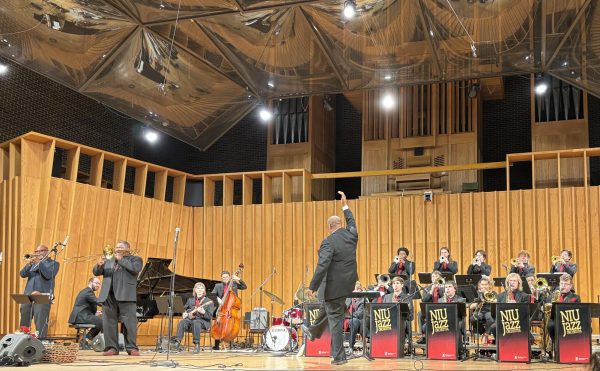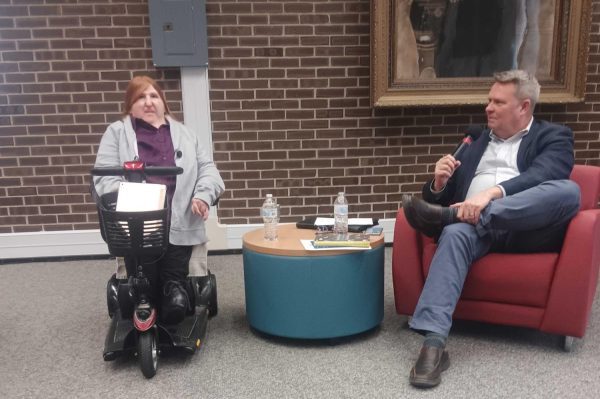Lights, Camera, Action!
February 10, 2005
Actors are peculiar.
Before every shot of “Edward Scissorhands,” Johnny Depp visualized himself as a brand new baby and a dog he once had because it helped make the character.
Renowned method actor Jack Nicholson worked himself into a rage, precariously tossing around an ax while repeating “ax, murder, kill” before shots for “The Shining.”
All actors, in some way, prep for roles. Their acting demands our attention and their social quirks and personal styles peak our curiosity, from Hollywood to local theater.
“Tartuffe” and “Misanthrope” debuted last week at NIU’s O’ Connell Theatre. With these debuts came the inevitable anxiety known as opening-night jitters.
For theater students, this is a well-known psychological phenomenon. The tension of three or more months of training, the cast’s hopes, the crew’s work and the theater program’s prestige riding on one’s shoulders can make anyone nervous.
Actors and actresses have stress management options. Method acting, an acting style which demands the actor to give up his or her own identity to the character’s, emphasizes relaxation as the only way to accurately do this. Any stress from real life will taint the actor’s ability to drop his or her ego. How to “loosen up” is up to the actor.
To see actors religiously clutching rabbit’s feet or repeating “in boca a lupo,” roughly translated to “in the mouth of the wolf,” and then spitting over a shoulder, may seem strange. But these rituals, according to psychology associate professor Brad Sagarin, are surprisingly natural.
“We’re all a little superstitious; it’s a function to deal with stress,” Sagarin said.
Alex Gelman, the director of “Misanthrope,” said he never sits on opening night.
Mary Holland, a theater arts acting major, has a superstition a bit more bizarre than Gelman’s.
“Before the show, we all rub a humpback,” Holland said.
Aaron Feuer, a theater arts acting major, remembered some rituals with religious undertones.
“I’ve seen tech members in previous shows praying to the ‘Tech God,’” Feuer said. “They set up candles and action figures.”
To contemplate the value of a ritual, one only has to think of its aim: to relax. If rubbing a human hunchback does relieve stress, then it works. While the hunchback may feel used, it may be worth it to find something willing to take one for the team if the performance consequently runs more smoothly.
“I don’t know if [the routine] helps, but if you feel better, it must be working. It’s all mental,” Sagarin said.
This phenomenon is not confined to theater. Rituals and traditions help teachers, athletes and students.
“Before the first class, I visualize the full classroom. I rehearse the first few lines,” Sagarin said.
He lives the first stressful moments in his mind before they happen and this serves as a calming agent.
NIU football tight end David Karonkiwicz puts on his pads the same way and listens to the same music as a set routine every time.
“If someone is performing repeated behaviors, a ritual can help a repeat performance be more likely,” Sagarin said.
But sometimes rituals can go too far.
“Those who suffer from obsessive compulsive disorder have taken rituals past a calming agent,” Sagarin said.
For some, rituals serve as a breaking point from reality to part of the event.
“It’s a powerful thing to see an actor go from the real world to that theatrical world,” said Chris Markle, assistant professor of theater director.
French Theater Company, the Theatre Dussle’eil, gives audience members front-row seats to the rituals and eccentricities of pre-performances by having the final prepping rooms on stage.
“While you may think seeing the actors preparing for the show may take away the mystique of acting, it usually just makes everything more mysterious than it really is,” Markle said.
Actors have been regarded as many things. They’ve been messengers from the gods, they’ve been hierarchically on par with beggars and transients, they’ve become sex icons and they almost always have remained enigmatic and eccentric to the public eye.
Rituals, by nature, are personal. And due to that nature, they are very attractive and mysterious.
The theater is caught up in many paradoxes: supposed outgoing individuals resorting to superstition to make the scrutiny bearable, uncountable hours of practiced choreography and the constant of improvisation and learning about oneself by being someone else.
The opening-night ritual is the chip in the actor’s calm facade that so many wooed spectators embrace, finding a bit of their fears and anxieties tied up with those of the actors, the characters and the production.










